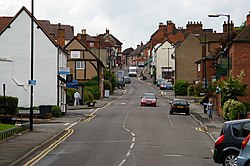Coleshill, Warwickshire
| Coleshill | |
| Warwickshire | |
|---|---|
 A view of Coleshill High Street looking southward | |
| Location | |
| Grid reference: | SP2089 |
| Location: | 52°29’56"N, 1°42’29"W |
| Data | |
| Population: | 6,343 (2001) |
| Post town: | Birmingham |
| Postcode: | B46 |
| Dialling code: | 01675 |
| Local Government | |
| Council: | North Warwickshire |
| Parliamentary constituency: |
North Warwickshire |
Coleshill is a market town in Warwickshire on the River Cole. It stands 11 miles east of Birmingham, though the conurbation spreads dangerously close to Coleshill and the motorways serving the city cut through the landscape close by. The broad A446 road curbs its western edge, running parallel with the M42 motorway, and the M6 motorway and M6 Toll cut the bottom of the town.
The town stands on a ridge between the rivers Cole and Blythe which converge to the north with the River Tame. A swathe of green belt land lies between Coleshill and the Birmingham growth, though it narrows to just 150 yards to the north near Water Orton, and just 700 yards at the southern tip of the town edge where Coleshill meets Chelmsley Wood.
History
Coleshill began life in the Iron Age, before the Roman conquest of AD 43, as the Grimstock Hill Romano-British settlement, north of the River Cole. Evidence of hut circles was found by archaeologists at the end of the 1970s. These excavations showed that throughout the Roman period there was a Romano-Celtic temple on Grimstock Hill. It had developed over the earlier Iron Age huts and had gone through at least three phases of development. The area was at the junction of two powerful Celtic Tribes - the Coritanii to the east from Leicester, and to the west the Cornovii from Viroconium Cornoviorum. In the sub-Roman period the nucleus of Coleshill moved about a mile to the south, to the top of the hill. Here the present church is set and the mediæval town developed around it.
By 1066 the town was a Royal Manor held by King Edward the Confessor and is recorded in the Domesday Book of 1086 as land held by the King. Henry II granted the manor to the de Clinton family, then it passed to the de Montford's who had moated manor houses at Coleshill and Kingshurst. King Henry VII granted the lands to Simon Digby in 1496. His descendants (Wingfield-Digby) still hold the titles.
Coleshill was granted a market charter by King John in 1207, the year he gave charters also to Liverpool, Leek and Great Yarmouth.
Simon Digby, who became a respected antiquary, was awarded the manor of Coleshill in 1496 by King Henry VII after the execution of Simon de Montford, who had assisted the Perkin Warbeck rebellion, an attempt to unseat the King.
During the era of coaching and the turnpike trusts, Coleshill became important as a major staging post on the coaching roads from London to Chester, Liverpool and Holyhead. At one point there were over twenty inns in the town. The Coleshill to Lichfield Turnpike dates from 1743.
Notable buildings
Many former coaching inns remain in Coleshill, mostly along the High Street and Coventry Road.
One of the most notable buildings in the town is the Parish Church of St Peter and St Paul at the top of the Market Square. It has a 170-foot-high steeple, one of the finest in Warwickshire, dating from the 13th century. Inside there is a 12th-century font of Norman origin, which is one of the finest examples in the country. There are also mediæval table tombs with effigies of Knights, including John de Clinton. Just outside the south door are the preserved remains of a mediæval cross.
The Market Square is also the location of the town's pillory and whipping post. Historically these were used to punish drunks, and bakers who sold underweight loaves. Today though, they are one of the town's tourist attractions, having been restored and preserved by the Gascoigne family, a local family who have run businesses in Coleshill for over 100 years.
At the top of Coleshill, just past Packington Lane, is a red pillar box that bears the Royal cipher of King Edward VIII, who succeeded to the Crown in 1936. It is one of a small number to have been placed before the King's abdication in the same year.
Transport
The town is close to the M6, M6 Toll and M42 motorways.
Until 2007, the town's nearest railway station was at Water Orton, some 2½ miles to the north-west, but a new station opened as Coleshill Parkway, adjacent to the old Forge Mills site and about a mile and a quarter east of Water Orton, on the 19 August 2007 approximately 16 weeks behind schedule due to construction delays. It is on the Birmingham to Peterborough Line and is served half-hourly on the service between Birmingham New Street, Nuneaton, Leicester, Peterborough, Cambridge and Stansted Airport.
Outside links
| ("Wikimedia Commons" has material about Coleshill, Warwickshire) |
- Coleshill Community
- Coleshill at British History Online

